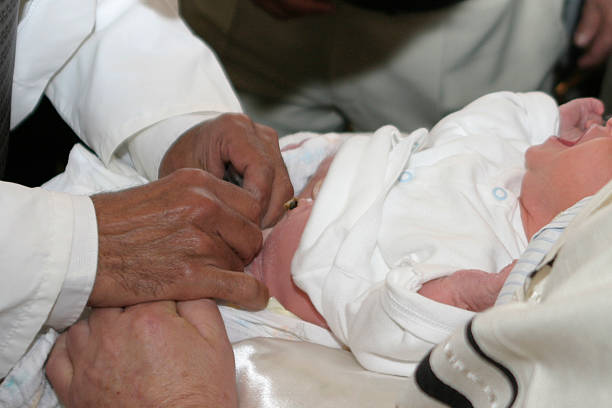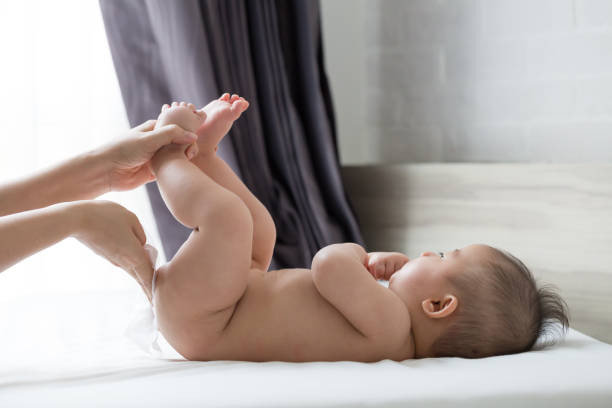Circumcision is a procedure viewed as a rite of passage to puberty in many cultures. However, more and more parents are opting to have it done while their son is still a baby, often to avoid future pain. But does it hurt to get circumcised even if it’s done during infancy?
Circumcision For Baby Boy
Your paediatrician might inquire about whether you want to have your boy circumcised as soon as he is born. The removal of your baby’s foreskin, the hood of skin that covers the top of their penis, is a reasonably routine surgery. If a newborn needs the procedure, it is typically performed two or three days after birth, just before they are discharged from the hospital.
Should Your Baby Boy Be Circumcised?
The question of whether boys need to be circumcised is a topic that sparks debate among parents and healthcare professionals. The American Academy of Pediatrics (AAP) states that the decision to circumcise a baby boy is entirely up to the parents. They neither recommend nor discourage the procedure, emphasizing that it is a personal choice.
“The health benefits of newborn male circumcision outweigh the risks, but the benefits are not great enough to recommend universal newborn circumcision,” stated the AAP.
When it comes to the pros, some arguments in favour of circumcision include potential hygiene benefits and a reduced risk of urinary tract infections, penile cancer, and sexually transmitted infections.
On the other hand, opponents of circumcision argue that it is an unnecessary procedure that can cause pain and carries the risk of complications. They also stress the importance of individual choice and bodily autonomy.
Ultimately, the decision to circumcise your baby boy should be based on your own beliefs, cultural or religious considerations, and discussions with your healthcare provider. It’s essential to weigh the potential benefits against the risks and make a decision that aligns with your family’s values and beliefs.
Baby Circumcision Surgery
If your boy is circumcised as a newborn, they will be awake throughout the process. The hospital is where it will most likely take place. Their arms and legs will be restrained using Velcro bands or other devices after they are put on their back.

Image from iStock
After using an antiseptic to disinfect the penis area, the doctor will provide an anaesthetic to the base of the penis to reduce pain. In some cases, doctors will use cream to apply the analgesic instead. After the procedure, your doctor may advise swaddling them by snugly wrapping them in a blanket or having them suck on a pacifier dipped in sugar water. Acetaminophen may also be given to your baby as a painkiller.
The Gomco clamp, the Plastibell device, and the Mogen clamp are three different types of clamps or plastic rings that are employed for circumcision. However, the process is the same for everyone.
The doctor clips off any extra foreskin after attaching the clamp or ring to the penis. The ring remains on and will eventually come off. The penis is then covered in gauze after the doctor coats it with an ointment like petroleum jelly. In most cases, it ends after 10 minutes. Your baby should be prepared to go home in a few hours if it is done in the hospital.
Does It Hurt To Get Circumcised For Babies?
Even if baby boys are given anaesthesia prior to the procedure, does it hurt to get circumcised regardless?
One mum blogger took to Instagram to share the reality of infant circumcision. In the post, which earned mixed reactions, the blogger highlighted just how painful circumcision can be.
A study published in the Paediatrics & Child Health Journal found that it does hurt babies, even with anaesthesia. What’s more, another study published in Pediatrics found that only 45 per cent of doctors use an anaesthetic when circumcising infants.
Normally, a baby is strapped down with a Circumstraint, or an apparatus with velcro cuffs to secure the baby’s hands and legs. The doctor will then apply an antiseptic to sterilise the area. Then, doctors can apply topical anaesthesia, which is as much as you can give babies, as sedating them would be risky. However, some studies claim local anaesthesia is also a safe option.
Because of this, they still can feel pain. To access the head of the penis and the inner foreskin, a doctor uses forceps to widen the tiny opening. Some parents and physicians view the act as “barbaric,” while others believe it is a necessary part of life.
Whatever you believe, one thing’s for sure: no parent wants to see their child in any pain.
Baby Penis After Circumcision
Your baby’s penis may appear red and swollen following circumcision. It might be covered in gauze and petroleum jelly. When your infant urinates, the gauze will probably come off. You should adhere to your doctor’s instructions regarding whether to reapply fresh gauze to your infant’s penis or not. Use warm water to moisten the gauze and slowly loosen it if you need to remove it from the penis.
The doctor may have performed the circumcision using a Plastibell gadget. If so, your child’s penis will be wrapped in a piece of plastic. In 10 to 12 days, the ring ought to come off naturally.
The day following the treatment, a thin, yellow coating could develop over the area. This is a typical aspect of healing. It ought to disappear in a few days.
While the region heals, your infant could seem fussy. Your infant may experience pain when urinating. In three to four days, this soreness typically subsides. But it might linger for as long as two weeks.
After three or four days, your baby’s penis will probably start to feel better, but it might also start to look worse. After seven to ten days, the penis frequently begins to appear to be improving.
Baby In Pain After Circumcision: Is There A Way To Minimise The Pain?

Though preferences vary among doctors, what’s certain is that circumcision causes pain and stress to newborns.
Researchers at Group Health Inc. and the University of Minnesota Institute of Child Development found that newborns “cry vigorously, tremble, and in some cases become mildly cyanotic [having blueness or lividness of the skin, caused by a deficiency of oxygen] because of prolonged crying” during circumcision.
Some studies even claim that babies remember the pain that comes with circumcision. It also rewires how their brain responds to pain in the future.
Infant circumcision is a decision you must make with the help of your child’s paediatrician as early as possible. Note that in some cases it can help prevent urinary tract infections (UTIs) in young boys. Circumcision can also prevent STDs or penile cancer in adult men.
If you do decide not to have your son circumcised, rest assured that this has no bearing on their future health or hygiene. Because cleaning an uncircumcised penis is pretty easy.
To minimise pain during circumcision, make sure to consult your child’s doctor as to the safest level of anaesthesia for newborns.
Though pain is an unavoidable part of the procedure, it doesn’t have to be unbearable for your baby.
Baby Circumcision After Care
The circumcised area may initially be red, sensitive, raw, and contain a little blood. During the first week of the healing process, there can be a tiny bit of yellow leakage on the end of the penis. By the third day, tenderness should be almost completely gone.
A Plastibell ring should detach in five to eight days if one was utilised. Avoid pulling the ring off because doing so could result in bleeding. Before the circumcision area heals entirely, it could take seven to ten days.
- Change your baby boy’s diaper regularly, every couple of hours, to prevent infections.
- Each time you change your baby’s diaper, replace the gauze dressing.
- Wash your hands before and after changing the gauze to prevent infection.
- Gently remove the gauze and wash the penis with warm water if the area that was circumcised becomes soiled with faeces.
- If the gauze is stuck to the circumcision region, gently remove it by moistening it with warm water.
- Gently blot or squeeze warm water onto the penis using a washcloth or cotton ball to clean it. To avoid stinging or irritation, avoid cleaning the penis with soap, lotion, powder, or baby wipes.
- Reapply pure petroleum jelly on a fresh piece of gauze. This will facilitate healing by preventing the penis from adhering to the diaper.
How To Prevent Infection After Getting Circumcised
Boys who have recently had circumcision as newborns require care to avoid infection and maintain their comfort.
Following circumcision, the American Academy of Family Physicians recommends the following preventive measures:

Image from iStock
- Each time you change your baby’s diaper, thoroughly wash the area with mild soap and water.
- If a bandage was applied to cover the area, change it every time you change your child’s diaper.
- If a Plastibell device was used, if it doesn’t fall off after 10 to 12 days, notify your doctor.
- Petroleum jelly can be used to ward off infection and itch.
- A small amount of blood in a baby’s diaper is normal, but if the stain is more than the size of a quarter, you should see a doctor without delay.
If you see any infection signs, such as fever, considerable redness or swelling, or a yellow discharge, call your doctor right once.
Call your paediatrician if:
- After three to five days, the circumcision area’s redness or swelling gets worse.
- Yellow pus has been present around the penis for more than a week.
- A Plastibell ring was utilised and remains in place for five to eight days.
Seek medical care immediately if:
- Bleeding from the circumcision location is present and is permeating the gauze.
- Six to eight hours after the circumcision, your child has not urinated.
- Your child’s urine leaks in dribbles or has a thin stream.
- The penis of your child is blue or black.
- Your child’s body temperature is higher than 100.4 °F.
- Your youngster has a yellowish-green discharge from the penis that smells bad.
Updates from Matt Doctor
Here at theAsianparent Singapore, it’s important for us to give information that is correct, significant, and timely. But this doesn’t serve as an alternative for medical advice or medical treatment. theAsianparent Singapore is not responsible for those that would choose to drink medicines based on information from our website. If you have any doubts, we recommend consulting your doctor for clearer information.